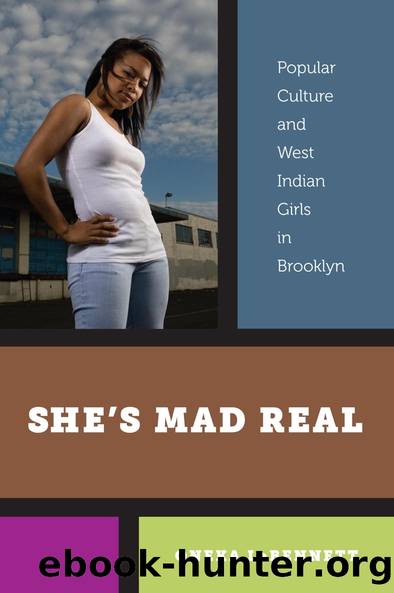She's Mad Real by Oneka LaBennett

Author:Oneka LaBennett [LaBennett, Oneka]
Language: eng
Format: epub
Tags: Social Science, Anthropology, Cultural & Social, Discrimination
ISBN: 9780814753125
Google: 9O-gBwAAQBAJ
Publisher: NYU Press
Published: 2011-07-25T02:53:36+00:00
Transnational Negotiations and Alliances
Considering music, television, and fashion, we find that these realms are principal arenas through which youth witness racial, ethnic, and gender representations as they assert particular identities. Take, for example, Tracy, a fifteen-year-old who was born in Trinidad but who moved to Brooklyn when she was just eleven months old. Tracy, whose mother is a social worker and whose father is a hospital cook, says her Trindadian family teasingly calls her a âYankeeâ because they perceive her to be very American. Yet, Tracy prides herself on her vast knowledge of West Indian musical artists who are not well known in the United States. Her favorites include, to name a few, Sizzla, Spragga Benz, Vybz Kartel, Marshall Montana, Bernard Collins, and my personal favorite, the Trinidadian Soca singer Oneka. Surprisingly, Tracy said, âYouâll only catch me listening to reggae or old R&B. I donât like rap at all. Everything [in rap] is mad cursing.â Here, Tracy is being critical of the musical genre dominant not only among Black youth but also arguably among all youth in America (a 2000 article in the New York Times titled âGuarding the Borders of the Hip-Hop Nationâ reported that 70 percent of all hip-hop CDs are purchased by White youth). In a fascinating contradiction that we will address shortly, Tracy criticizes profanity in rap music but turns the other cheek to the violent masculinity promoted by dancehall artists such as Vybz Kartel.9 Tracy, like other teens, allied herself with West Indian artists and musical genres when she wished to assert a West Indian identity. Here, not wishing to confirm her familyâs âYankeeâ label, Tracy disassociated herself from American music.
Whether girls allied themselves with West Indian or African American musicians also had to do with factors such as seeking parental approval; parents often saw American hip-hop as a corruptive influence because of its violent and sexually explicit lyrics. Girlsâ identity assertions and consumption choices were also motivated by looking to distance themselves from the negative stereotypes I mentioned earlier. Still, youth who privately professed their preferences for West Indian artists and claimed West Indian authenticity by downloading obscure artists or getting relatives to bring back the latest West Indian CDs contradicted such assertions when they were among African American peers. Often, such youth sang along with and knew all of the words when their African American counterparts played the latest chart-topping hip-hop song. Therefore, West Indian youthsâ choices and identifications were contradictory and contingent on a whole host of factors.
Unlike BCM, where children and youth engaged in play-labor, the Flat-bush YMCA was strictly a site of play. Music could always be heard at the YMCA, and the television in the lounge was often on. The cheerleadersâ use of music in their practice sessions enabled me to contextualize songs within the ethnographic space of the YMCA. The YMCA girls negotiated contradictory gender politics in relation to popular female hip-hop artists such as Lilâ Kim and Foxy Brown. On the one hand, they admonished Kim
Download
This site does not store any files on its server. We only index and link to content provided by other sites. Please contact the content providers to delete copyright contents if any and email us, we'll remove relevant links or contents immediately.
| Early Childhood | Parenting Boys |
| Parenting Girls | School-Age Children |
| Single Parents | Teenagers |
The Lost Art of Listening by Michael P. Nichols(7367)
Rich Dad Poor Dad by Robert T. Kiyosaki(6327)
We Need to Talk by Celeste Headlee(5509)
I Love You But I Don't Trust You by Mira Kirshenbaum(3784)
The Complete Idiot's Guide to Coping With Difficult People by Arlene Uhl(3102)
Rich Dad Poor Dad: What The Rich Teach Their Kids About Money - That The Poor And Middle Class Do Not! by Robert T. Kiyosaki(2883)
The Book You Wish Your Parents Had Read (and Your Children Will Be Glad That You Did) by Philippa Perry(2423)
A Burst of Light by Audre Lorde(2418)
Life Hacks by Dan Marshall(2398)
Dealing with People You Can't Stand by Dr. Rick Brinkman(2309)
An Odyssey by Daniel Mendelsohn(2246)
The Expectant Father by Armin A. Brott & Jennifer Ash(2198)
Teach Your Child How to Think by Edward De Bono(2116)
No Time to Say Goodbye(2035)
The Out-of-Sync Child by Carol Stock Kranowitz(2010)
What I Need by J. Daniels(2005)
The 7 Habits Of Highly Effective Teens by Covey Sean(1978)
I Don't Belong to You by Keke Palmer(1943)
The Self-Driven Child by William Stixrud PhD & Ned Johnson(1904)
